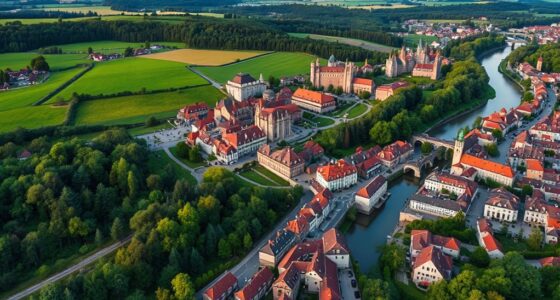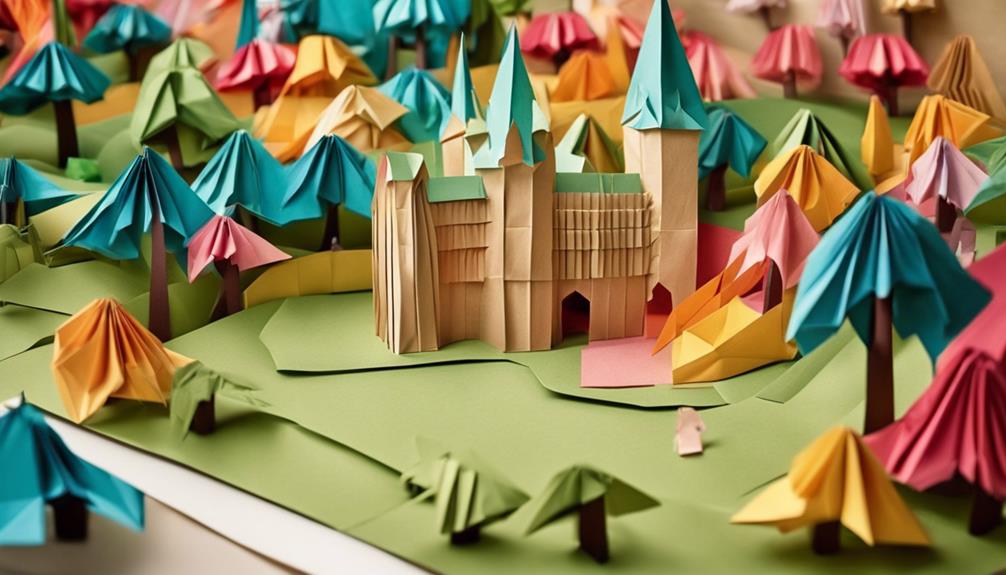If you visit Luxembourg, don’t miss exploring its historic fortifications like the Bock Casemates and Chemin de la Corniche for stunning views and rich history. Check out architectural landmarks such as the Grand Ducal Palace and Luxembourg Cathedral, which showcase regal elegance and Gothic beauty. Take a stroll through the charming Old Town and scenic river valleys for natural tranquility. Keep exploring to discover even more of Luxembourg’s vibrant culture, history, and breathtaking scenery.
Key Takeaways
- Explore the historic fortifications like Bock Casemates and Pétrusse Casemates with guided tours and panoramic views.
- Visit the Grand Ducal Palace and Luxembourg Cathedral for stunning architecture and cultural significance.
- Walk along Chemin de la Corniche and Bock Promontory for scenic views of the city and fortress ruins.
- Discover the charming Old Town and Grund neighborhood, featuring medieval streets, vibrant nightlife, and picturesque scenery.
- Enjoy natural sites such as Parc de la Ville, Pétrusse Valley Park, and botanical gardens for relaxation and outdoor activities.
Historic Sites, Architecture, and Natural Beauty

Luxembourg is a mesmerizing city where history, architecture, and natural beauty come together to create unforgettable experiences. As you explore, you’ll discover the city’s rich past through its impressive fortifications and underground tunnels. The Bock Casemates stand out as an extensive network of underground tunnels and artillery galleries that date back to the 18th century. Built by the Austrians, these tunnels offer panoramic views and a fascinating glimpse into Luxembourg’s military history. Nearby, the Pétrusse Casemates provide another set of fortified tunnels near the Grand Ducal Palace. Guided tours here feature modern lighting effects that enhance the atmospheric experience, making history come alive beneath your feet. The Wenceslas Wall, a 14th-century fortification, once protected the river valley below, and you can still walk along sections of this historic defense. For a scenic stroll with historical significance, the Chemin de la Corniche, often called “Europe’s most beautiful balcony,” traces the city’s 17th-century ramparts and offers breathtaking views over the deep valley.
Discover Luxembourg’s rich history through its fortifications, tunnels, and scenic views along the Chemin de la Corniche.
Moving to architectural landmarks, the Grand Ducal Palace serves as the official residence of the royal family and embodies intricate architectural detail that reflects Luxembourg’s regal heritage. Not far from here, the Gothic Revival Luxembourg Cathedral, with its stunning stained glass windows and royal crypt, invites you to appreciate its spiritual and artistic significance. The Adolphe Bridge, an iconic early 20th-century stone arch, is a favorite spot for capturing city views and marveling at engineering prowess. The lively public squares of Place d’Armes and Place Guillaume II host markets, festivals, and are surrounded by historic buildings, offering a lively pulse of the city. For a modern touch, museums like the National Museum and Lëtzebuerg City Museum provide interactive exhibitions that showcase Luxembourg’s history and art.
In the Old Town and scenic districts, the Grund neighborhood along the Alzette River enchants visitors with its quirky streets, vibrant nightlife, and picturesque scenery. The UNESCO-listed Old Quarters preserve medieval streets and historic buildings within walking distance of cultural attractions. From the Bock Promontory, you can enjoy sweeping views over the Alzette River valley and explore fortress ruins that echo the city’s strategic past. The Place des Martyrs, a historic square near the Old Town, hosts events and is lined with cozy cafes. The promenade along the Alzette River offers tranquil green spaces and scenic views of luxurious residences, perfect for relaxing walks.
Luxembourg’s natural beauty is equally enthralling, with gardens like the Jardin de la Papon, a butterfly garden where vibrant species flutter amid lush flora. Central parks such as Parc de la Ville and Parc Municipal provide peaceful spots for picnics, strolls, and recreation. The Pétrusse Valley Park is a green corridor through the city with hiking paths and scenic vistas, while the Botanical Gardens showcase a diverse range of plant species for education and leisure. As you navigate through these attractions, it’s clear that Luxembourg seamlessly combines history, architecture, and nature to create an unforgettable experience at every turn.
Frequently Asked Questions
What Are the Best Times of Year to Visit Luxembourg’s Attractions?
You should visit Luxembourg in late spring (May to June) or early fall (September to October) when the weather is mild and pleasant. During these months, you can enjoy outdoor attractions without the summer crowds. Summer (July and August) is lively with festivals, but it can be crowded. Winter offers festive markets, but be prepared for colder weather. Choose your timing based on your preferences for outdoor activities or cultural events.
Are There Any Family-Friendly Activities or Parks in Luxembourg?
Like a treasure chest waiting to be explored, Luxembourg offers plenty of family-friendly activities and parks. You can visit Parc Merveilleux, where kids can enjoy rides, animals, and fairy-tale scenery, or explore the lush grounds of the Pétrusse Valley for picnics and walks. These spots keep children entertained and active, making your trip memorable. Pack some snacks and enjoy quality family time amid Luxembourg’s beautiful outdoor spaces.
How Accessible Are Luxembourg’s Main Attractions for Disabled Visitors?
Luxembourg’s main attractions are quite accessible for disabled visitors. Many sites feature ramps, elevators, and accessible pathways, making it easier for you to explore comfortably. Public transportation also offers facilities for mobility-impaired travelers. However, some historic areas might have uneven surfaces or limited access. It’s a good idea to check specific sites beforehand to verify they meet your needs and help you enjoy your visit fully.
What Local Cuisine Should I Try Near Luxembourg’s Top Sites?
Imagine tasting a secret map that leads you through Luxembourg’s vibrant flavors. Near its top sites, you should try hearty Judd mat Gaardebounen, rich with smoked pork and beans, symbolizing warmth and tradition. Don’t miss Gromperekichelcher, crispy potato fritters that echo local street life. These dishes reveal Luxembourg’s soul—comforting, lively, and full of history—offering you a delicious journey alongside your exploration.
Are There Guided Tours Available for Luxembourg’s Major Attractions?
Yes, you can find guided tours for Luxembourg’s major attractions. Many tour companies offer walking, bus, or private guided options, allowing you to explore historical sites, castles, and museums with expert insights. You should book in advance, especially during peak seasons, to guarantee availability. Whether you prefer a group experience or a customized tour, these guides help you get the most out of your visit, making your trip more enriching and enjoyable.
Conclusion
Luxembourg’s blend of historic sites, stunning architecture, and natural beauty offers an unforgettable experience. With over 1,200 castles scattered across the country, you’ll see history come alive at every turn. As you explore, remember that Luxembourg’s lush green landscapes cover about 50% of its land area, showcasing its commitment to preserving nature. So, whether you’re wandering ancient streets or relaxing amidst scenic views, Luxembourg promises a rich, enthralling adventure that’ll leave you inspired.







